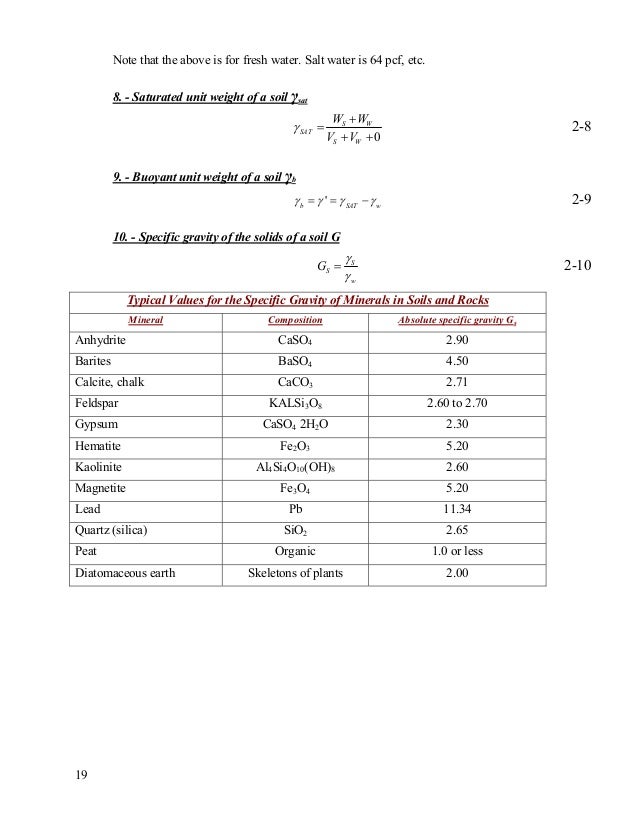-
Saturated Unit Weight Of Soft Clay카테고리 없음 2020. 2. 29. 00:15
Dry unit weightGeotechdata.info - UpdatedSoil unit weight, as referred to as Specific weight, is the weight per unit volume of soil. It may refer to- Wet unit weight: Unit weight of the soil when the pore are fully or partially filled with water.- Dry unit weight: Unit weight of the soil the pores are filled only with air without any water.Gammad = Gamma / (1 + w)whereGammad: dry unit weightGamma: unit weightw: soil water contentTypical values of soil porosity for different soilsThe soil unit weight, of course, depends on the packing, compaction, and humidity condition of the soil. Some typical values of dry unit weight are given below for different soils. The values correspond to normally consolidated condition unless otherwise stated.
Geotechnical Aspects of Pavements Reference Manual Chapter 5.0 Geotechnical Inputs For Pavement Design 5.1 IntroductionThis chapter describes the determination of the specific geotechnical inputs required for the design of flexible and rigid pavements. Although the focus here is strictly on geotechnical inputs, there is obviously much other important information required for pavement design, including traffic characteristics, material properties for the bound asphalt and/or Portland cement concrete layers, desired reliability, and other details. These inputs are usually provided by agency units other than the geotechnical group.Most of the inputs described in this chapter relate to the material properties of the unbound pavement layers and subgrade soil. Other required inputs include geometric information like layer thickness, but these are generally self-explanatory and are not discussed here. Environmental/climate inputs are also covered in this chapter. Although these inputs are not 'geotechnical' per se, they directly influence the behavior of the unbound materials through their effects on moisture content and freeze/thaw cycles.
In addition, in many agencies, the group responsible for determining the environmental inputs is poorly defined, and thus this responsibility may end up with the geotechnical group.The coverage of the material in this chapter is guided by several considerations:. Only the explicit design inputs are treated. As described in Chapter 3, there may be other geotechnical issues ( e.g., embankment slope stability) that can have a significant impact on pavement performance but that are not considered explicitly in the pavement design process. Project-specific measured input parameters are often unavailable at design time, particularly for preliminary design. This is especially true for material properties. Consequently, much emphasis is placed in this chapter on 'typical' values and/or empirical correlations that can be used to estimate the design inputs.
These estimates can be used for preliminary design, sensitivity studies, and other purposes. Clearly, though, project-specific measured values are preferred for final design. Many material property inputs can either be determined from laboratory or field tests. Field testing is covered in Chapter 4, and appropriate links to the Chapter 4 material are included here where appropriate.
The treatment in this chapter attempts to balance coverage between the current empirical 1993 AASHTO Design Guide and the forthcoming mechanistic-empirical NCHRP 1-37A design approach (hereafter referred to as the NCHRP 1-37A Design Guide). Although there is some overlap in the geotechnical inputs required by these two design approaches ( e.g., subgrade resilient modulus), there are substantial differences. The inputs to the 1993 AASHTO Guide are fewer in number and mostly empirical ( e.g., layer drainage coefficients), while the inputs to the NCHRP 1-37A Guide are more numerous and fundamental ( e.g., hydraulic conductivity vs. Moisture content relations). Only design inputs are described in this chapter. In cases where some intermediate analysis is required to determine the design input ( e.g., for effective modulus of subgrade reaction in the 1993 Guide-see Section 5.4.6), the analysis methodology is described here, as well.

Saturated Unit Weight Of Soft Clay Powder
The usage of the design inputs in the overall design calculations is described separately in Appendices C and D for the 1993 and NCHRP 1-37A Design Guides, respectively.One consequence of all of the above is that this chapter is quite long; this is necessary to give sufficient coverage to all of the diverse geotechnical inputs required by the two design procedures. First, the geotechnical inputs required by the 1993 AASHTO and NCHRP 1-37A Design Guides are summarized (Section 5.2). Then, the geotechnical inputs are described in detail by category.